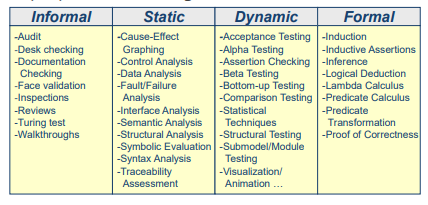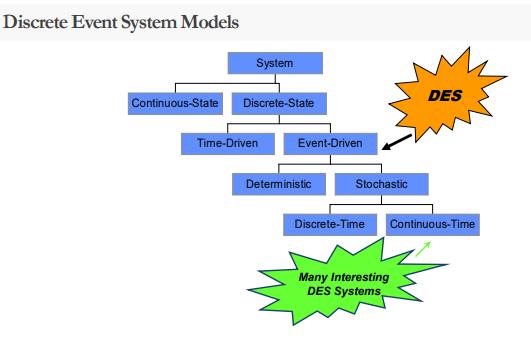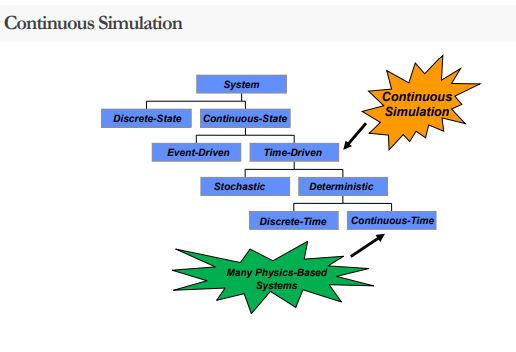CHAPTER 1
1/58
There's no tags or description
Looks like no tags are added yet.
Name | Mastery | Learn | Test | Matching | Spaced |
|---|
No study sessions yet.
59 Terms
simuland
is the real - world item of interest. It is the object, process, or phenomenon to be simulated
model (schematic)
is a representation of a simuland.
Mechanical diagram
is used to develop a mathematical model for the car suspension system
Differential equations
are programmed for computer solution using a “continuous simulation” software tool
continuous simulation
Differential equations are programmed for computer solution using a “__” software tool
Simulation
is the process of executing a model over time
Attribute
A significant or defining property or characteristic of a model or simulation.
• Fidelity • Resolution • Scale
Three important attributes
Fidelity
. Accuracy of model’s representation or simulation’s results.
Fidelity
AKA validity.
Reality Representation Requirements
Fidelity is relative to:
Reality
- How closely does the model match reality? - How consistent are the simulation results and the real world in the same scenario?
Representation
- Some aspects of modeled system represented, others not, more or less; fidelity varies by aspect
Requirements
- Different applications require different levels of fidelity
Resolution
. The degree of detail with which the real-world is simulated. More detail is higher resolution
Resolution
. AKA granularity.
Scale.
Size of the overall scenario or event the simulation represents.
Scale
AKA level
Component Equipment
Typical scales for manufacturing systems:
Component
- System, subsystem, or single unit of a factory
Equipment
- 1, 10 or 100 machines
VV&A Verification, Validation, and Accreditation
The process of determining if a model is correct and usable; the process of developing and delimiting confidence that a model can be used for a specific purpose.
Verification
. The process of determining that a model implementation accurately represents the developer’s conceptual description and specifications.
Verification
Is it coded right? Does the implementation match the design?
Verification
This is software engineering quality. General software testing methods apply
Validation
. The process of determining the degree to which a model (and data) is an accurate representation of the real world from the perspective of the model’s intended usage.
Validation
Is the right thing coded? Does the model match reality (i.e., fidelity)?
Validation
This is modeling quality. Special validation methods are necessary.
Verification and validation techniques

Accreditation
. Official certification by a responsible authority that a model is acceptable for a specific purpose
Accreditation
For a specific purpose or function
Not a blanket or general-purpose approval
Authority is agency or person responsible for results or use of model, not developer
• Static or Dynamic
• Continuous-State or Discrete-State
• Time-Driven or Event-Driven
• Deterministic or Stochastic
• Continuous-Time or Discrete Time
» System Classification
state of a system
» The __ at time to is the information required at to such that the output y(t), for all t>to , is uniquely determined from this information and from the input x(t) for t>to
state variables.
» This state information is usually represented by a vector q(t) whose components are called
state space
» The __ of a system, denoted by Q, is the set of all possible values that q(t) may take.
Static System
• A system in which the output depends only on the input and is independent of the system state
• A system without memory
Dynamic System
• A system in which the output depends on both the input and the system state
• A system with memory
Continuous-State System
A system in which the state space Q consists of vectors which can assume a continuum of values. We say that q(t) ε R (reals).
Discrete-State System
A system in which the state space Q consists of vectors which can assume only a discrete set of values. We say that q(t) ε I (integers). As a consequence, state changes occur at distinct time instants.
event
An __is a specific instantaneous action or occurrence which results in an instantaneous change of system state.
event-driven
An event is a specific instantaneous action or occurrence which results in an instantaneous change of system state. We call such systems “__” systems.
time-driven
The system response varies as a continuous function of time, even when there is no change in the system input. Thus, the system state appears to evolve simply because time advances. We call these systems “__” systems
Deterministic System
: A system in which all variables are deterministic. It will produce the same output from a given starting condition or initial state.
Stochastic System
: A system in which one or more variables has uncertainty or variability.
Stochastic System
In this case, the system state becomes a random variable and a probabilistic framework is required to describe system behavior
Continuous-Time System
: A system in which the time variable is represented by a continuous variable; t ε R.
Discrete-Time System
: A system in which the time variable is represented by a discrete variable, t ε I. Usually, the intervals between time values are equal. The discrete time points are labeled to , t1 = to+T, t2 = to+2T, … .
Discrete Event System (DES)
A __ is a discrete-state, event-driven system.
Discrete Event System (DES)
, state evolution depends entirely on the initial state of the system and the occurrence of asynchronous discrete events over time
discrete state space Q and the discrete event set E
» Important characteristics of a DES are the
Continuous System
is a continuous-state, time-driven system.
Continuous System
Many physics-based systems are modeled as
» Monte Carlo Simulation » Discrete Event Simulation » Continuous Simulation » Agent-Based Simulation
Simulation Paradigms
» Monte Carlo Simulation
• Static systems modeled using probability • Simulation of a random experiment • Implemented using spreadsheets and the relative frequency interpretation of probability
» Discrete Event Simulation
• Dynamic systems modeled as queuing systems
• Simulation of discrete-state, event-driven systems
• Implemented using spreadsheets or DES tools (Arena)
» Continuous Simulation
• Dynamic systems modeled using differential equations
• Simulation of continuous-state, time-driven systems
• Implemented using spreadsheets or CS tools (Matlab-Simulink)
» Agent-Based Simulation
• Generally a bottom up approach to represent human and social systems
• Usually stochastic in nature
• Implemented in various ways from a computational standpoint (ex. Netlogo)

